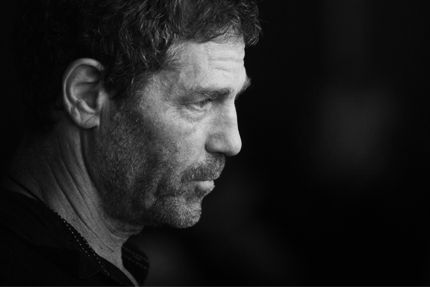
Naharin is arguably the foremost choreographer in the world.
Rather than watch an hour of accomplished performance, Naharin would prefer to see five seconds of something sublime — that indefinable quality described by the thinker Edmund Burke as ‘delightful horror’.
As a dance maker, Naharin has been so internationally successful because his work has often been so generous with its universally accessible resonances. […] Simply put, it’s dance that pulls you close.
Dance Open 2017:
Naharin's Virus, performed by Batsheva Dance Company
Ohad Naharin in his own words
You need to be aware of your relationship with the world, with the elements. If you are watching yourself, you aren’t looking at what is going on.
Throughout my life I was confronted with different dance methods, and then I got injured and all of these things really initiated my research. My own experiences and body, as well as my friends, colleagues and dancers that I work with became my laboratory.
We share a philosophy about why we dance, how we want to dance, why we want to be together, and we appreciate each other because it lends so much to why we live and how we can survive in this already difficult act of “living”.
Ohad Naharin
Ohad Naharin has been hailed as one of the world’s preeminent contemporary choreographers and his work stands in the front row of contemporary dance.
Since becoming the Artistic Director of Batsheva Dance Company, Naharin has established its status as one of the most beloved and appreciated international dance companies in the world.
Born in 1952 on Kibbutz Mizra, Ohad Naharin began his dance training with Batsheva Dance Company in 1974. During his first year with the Company, guest choreographer Martha Graham singled out Naharin for his talent and invited him to join her own company in New York. Whilst in New York, Naharin studied on a scholarship from the America-Israel Cultural Foundation at the School of American Ballet, The Juilliard School, and with Maggie Black and David Howard. He went on to perform one season with Israel’s Bat-Dor Dance Company and Maurice Bejarts Ballet du XXe Siecle in Brussels.
Naharin returned to New York in 1980, making his choreographic debut at the Kazuko Hirabayshi studio. From 1980 until 1990, Naharin has presented his works in New York and abroad and was invited to create works for different companies, including Batsheva, the Kibbutz Contemporary Dance Company, and Nederlands Dans Theater. Simultaneously, he regularly worked in New York with a group of dancers on different projects, together with his first wife, Mari Kajiwara. Naharin and Kajiwara worked together for many years, up to her death from cancer in 2001.
Naharin was appointed Artistic Director of Batsheva Dance Company in 1990 and has served in this role until today. During his tenure with the company, Naharin choreographed over 30 works for Batsheva and its junior division, Batsheva — the Young Ensemble. Alongside his work as a choreographer, Naharin developed Gaga, an innovative movement language intended for everyone. The dancers of Batsheva Dance Company train with Gaga on a daily basis, and it is also taught to dancers and the public worldwide by certified teachers.
Naharin trained in music throughout his youth, and he has often put these skills to use. He collaborated with the Israeli rock group The Tractor’s Revenge (for Kyr, 1990), Avi Balleli and Dan Makov (for Anaphaza, 1993), and Ivri Lider (for Z/na, 1995) and Grischa Lichtenberger (for Last Work, 2015). The multidisciplinary artist Ohad Fishof edited and mixed soundtracks for Three (2005), Telophaza (2006) and Furo (2006), and Maxim Waratt composed music for MAX (2007) and edited and mixed the soundtracks for Mamootot (2003), Hora (2009), Sadeh21 (2011) and The Hole (2013).
His works have been performed by prominent international companies including Nederlands Dans Theater, Ballet Frankfurt, Lyon Opera Ballet, Compania Nacional de Danza (Spain), Cullberg Ballet (Sweden), the Finnish National Ballet, the Paris Opera Ballet, Bale' da Cidade de Sao Paulo, Cedar Lake Contemporary Ballet (New York), Hubbard Street Dance Chicago, Les Grand Ballets Canadiens de Montreal, Alvin Ailey Dance Theater, Atlanta Ballet, The Royal Danish Ballet, Le Ballet de l’Opera National de Bordeaux (France) and more.
Naharin’s work was documented in several movies. The rehearsal process with Cedar Lake Contemporary Ballet during a restaging of Decadance was the subject of Tomer Heymann’s documentary Out of Focus (2007). In 2015, the Heymann Brothers' comprehensive documentary about Naharin “Mr. Gaga” was released.
Ohad Naharin has won many awards and honors, namely: Chevalier de l’Ordre des Arts et des Lettres from the French government (1998), New York Dance and Performance (Bessie) Award for Naharin’s Virus (2002), New York Dance and Performance (Bessie) Award for Anaphaza (2004), a Doctor of Philosophy honoris causa by the Weizmann Institute of Science (2004), the Israel Prize for dance (2005), a Doctor of Philosophy honoris causa by the Hebrew University (2008), the EMET Prize in the category of Arts and Culture (together with Yair Vardi, 2009), the Samuel H. Scripps American Dance Festival Award for Lifetime Achievement (2009), Dance Magazine Award (2009), an honorary Doctor of Fine Arts degree from the Juilliard School in New York (2013), Honorary Fellowship by the Tel Aviv Museum (2014) and an Honorary Fellowship by the Rupin Academic Center (2015), The Carina Ari Medal, Sweden (2016), Award for Excellence in the Arts in Israel, The Harvard Club of Israel (2016). Naharin will participate this year in the prestigious Rolex Mentor-Protégé Arts Initiative, and will serve as mentor for Londiwe Khoza, a young dancer from South Africa.
Festival Team: This email address is being protected from spambots. You need JavaScript enabled to view it.
Tickets: This email address is being protected from spambots. You need JavaScript enabled to view it.
Accreditaion and Cooperation: This email address is being protected from spambots. You need JavaScript enabled to view it.
